The Forty Foot: A Retrospect BUILDING TIME.

The Forty Foot: A Retrospect L.A.G Strong
Well, that’s ten years ago and more, And I am far from Kelly Shore
And Ring Rock: no one that I love Is left at all in Sandycove . . . Dockrell, Tallon, Tagert - where Are the men I worshipped there?
Some still rub the pink flesh dry, Some have laid their towels by. Some go by the Round Tower still Some are passed to Hy-Brazil
Where Fawcett, he that dived and died, Now plunges in a fairer tide.
(Strong, Power & Pearson, 1987, p134)
The Forty Foot: A Retrospect Building Time.
 Nicole Burke Andrew Meaghar Brian Stedmond Shóna Quigley Co-ordinator: Donal Hickey
Photograph of Artist Joseph Bueys at Sandycove (Tisdall, 1994)
Nicole Burke Andrew Meaghar Brian Stedmond Shóna Quigley Co-ordinator: Donal Hickey
Photograph of Artist Joseph Bueys at Sandycove (Tisdall, 1994)
KAVANAGH’S
THE HARBOUR
Sandycove Bathing Areas Site Plan
FORTY
FOOT
1
THE FORTY FOOT
The Forty Foot, probably the most famous bathing place in Ireland, is situated on the south shore of Dublin Bay, near Dún Laoighaire harbour. It is located at the tip of Sandycove Point, a pleasant promontoru where outcrops of granite disappear into the sea and rocky pools providing an abudance of nooks and crannies for crab fishing, swimming and general exploration of the sea.
Building Time / The Forty Foot / History 2
People Diving from the Forty Foot [photograph] (unknown, n.d.)

The sea surrounding the Forty Foot runs deep and rarely lies still. North-east winds can bring ominous waves, especially in the winter, forcing the sea to swallow the steps, handrails and concrete benches of the Forty Foot. But mostly, the Forty Foot is a place of place of beauty, tranquility and enjoyment.

Building Time / The Forty Foot / Introduction 4
Forty Foot Gate
5
Origin of the Name
There have been a lot of theories and disputes regarding the origins of the name given to the Forty Foot, one being that the water is forty foot deep; this however has been proven untrue as the water sits at an average depth of twenty feet at full tide. (Power & Pearson, 1987, p.79) Another theory is that Marine Road was forty foot wide, and another was that battery was at one time the garrison for the Fortieth Foot Regiment. (Famous Baths, n.d. para. 6)
The name ‘The Forty Foot Hole,’ has been referenced from as far back as the mid 1800s. The inclusion of the word ‘hole’ in the name alludes to earlier origins. As Sandycove Harbour was commonly used fishing, it is believed that the name was given to the Forty Foot by fishermen rather than bathers. Across Ireland some of the greatest deep-water pools include, “Long Hole,” “Philips Hole,” “Cotton Hole,” “Pollock Hole” which were all known as fishing grounds long before they became bathing spots. Therefore, it is believed by Mr. Kevin A. Murray, who has lived in Sandycove for many years, that the name of the famous bathing place was most likely given by the local fishermen rather than by bathers. (Power & Pearson, 1987, p.81)
Building Time / The Forty Foot / Introduction 6
“In 1863 the Kingstown Commissioners obtained the consent of the Ballast Office to the making of a public bathing place at Sandycove, and engineers of both bodies arranged the details. It was agreed that two bathing places could be provided in front of the Battery, one for swimmers in deep water by cutting an entrance three feet deep in the rock, erecting a diving board, and by making steps and rails: and a second bathing place for those unable to swim. It was agreed that the stranf at Bell Rock should be cleared of stones, and cork rings provided for the safety of those using the place.”
(Wall, 1962, p.12)
7

/ Introduction
‘People Standing on Rocks at Martello Tower’ [photograph] (National Library of Ireland, 1911)
Building Time / The Forty Foot
Rocque, J., (1756). Dublin 1756, Reproduced in Bruton, M., Convery, et al., (1987), Sheet no. unkown. Scale unknown. Managing Dublin Bay, University College Dublin.

9
Ltc. Leach, R.P. (1862) Matello Tower no.11 and Sandcove Battery, County of Dublin, Corrected Jan. 1883, 50 feet to an inch. National Archive

Building Time / The Forty Foot / Historic Mapping
10
Boundary Commission (1834) Dublin and Kingstown Railway [map] sheet 15. part 2. Dublin Historic Maps

Building Time / The Forty Foot / Historic Mapping
11
The Admiralty, (1874). Dublin Bay, 7th edition, Sheet 1415, 1:24500, London. National Library of Ireland

Building Time / The Forty Foot / Introduction 12
Ordenance Survey (1888) County Dublin: Town of Kingstown and Township of Dalkey [map], Sheet XXIII.57, Scale: 1:1056. UCD Digital Library

13

14
Civic Survey(1936) Dun Laoghaire Borough Development Map [map] sheet no. unkown. 1:5250 Dublin Historic Maps

15
Civic Survey(1936) Dun Laoghaire Borough Geology Map [map] sheet no. unkown. 1:5250 Dublin Historic Maps

16

17
Forty Foot: Gentlemen Only [photograph](Power & Pearson, 1987)

Building Time / The Forty Foot / Culture
18
Eddie Heron, Sandycove S.C. [photograph](Power & Pearson, 1987)
Thursday, 31 July, 1947
The Evening Herald
“The famous Forty Foot swimming place at Sandycove is an institution. Generations of Dubliners, scattered the world over have glorious memories of summer swims there with the wide waters of the Bay shimmering in the sun, the fretted coastline as picturesque as any Mediterranean littoral and the Bailey Lighthouse, gleaming white on the distant slopes of Howth Head. It always has been a place for seasoned swimmers, for men who set more store by the joys of a header into the open sea than on dressing accommodation, and were more than content if the spring boards were satisfactory. Within the sheltering circle of rocks they basked, chatted and smoked between swims, considered the concrete-smoothed surface underfoot the height of luxury. Here laity, professional men and humble clerks, brain workers and labourer mingled in a happy brotherhood of swimmers and went away refreshed in body and mind.”
(Power & Pearson, 1987, p.84)
19

Building Time / The Forty Foot / Culture
20
Swimmers Dive into the Forty Foot on Christmas Day’ [photograph] (O’ Shea, 1971)

21
Sandycove Bathers’ Association 1909 [photograph] (Power & Pearson, 1987)
18th June 1968
Minutes from the Sandycove Bathers Association Meeting
The President explained he had convened the meeting in consequence of the publicity given by the Press to an incident which occurred on Sunday afternoon sixteenth June, when a woman accompanied by two male companions invaded’ the Forty Foot and despite the protests of the President and two other members of the Association, and in the presence of approximately 50 male bathers insisted on entering the sea from the platform. He wished to know what action the Association intended to take in the matter and what steps could be taken to avoid a repetition of a similar intrusion. The Hon. Sec. stated that he had been interviewed by members of the Press and had pointed out to that body the rules governing bathers in the Forty Foot. He had also forwarded a letter to the Editor of the Dublin Evening Herald describing what actually occurred in the Forty Foot on the Sunday afternoon in question. After a lengthy discussion it was unanimously agreed to draft a letter and send a copy of such letter to all morning and evening newspapers.
(Power & Pearson, 1987, p.95)
Building Time / The Forty Foot / Culture 22
A Woman’s View
Jane Dillon Byrne

“Unfortunately, many of the male users are still not gentlemen. I ask myself, is the present position of exclusion one of challenge, fear, exclusivity, demeaning of women or power, power over women? ‘Stay out of our place,’ is the message. Yet in civic terms, the Forty Foot is a public place, all people can use it any time. So, women cannot use the two covered shelters, regardless of weather conditions. Once in 1994, four of us were invited by one member, a gentleman, to use the small round shelter at the entrance: we did; and he was roundly abused by the other members present. No offers have been made since then.”
(Byrne, Power & Pearson, 1987, p.87)
23
‘Gentlemen’s
Bathing Place’’ (RTE Archives, 1989)


25
Women Bathers [painting] (Short, 2021)
Forty Foot Men (and Women Too!)
Liam Ó
Murchú
“The idioms change: a Forty Foot morning is not the same as a Forty Foot midday and neither is the same as a Forty Foot night. There are morning, midday and evening people - the clientèle changes with the colour of the sky. You could be swimming in the Forty Foot for years and never meet someone else who was swimming there. “
(Ó Murchú, Power & Pearson, 1987, p.120)
‘Dogs & Bicycles Prohinited ‘ [drawing] (Wall, 1962, p. 20)

Building Time / The Forty Foot / Culture
26
Woodshadows floated silently by through the morning peace from the stairhead seaward where he gazed. Inshore and farther out the mirror of water whitened, spurned by lightshod hurrying feet. White breast of the dim sea. The twining stresses, two by two. A hand plucking the harpstrings merging their twining chords. Wavewhite wedded words shimmering on the dim tide.
The sea, the snotgreen sea, the scrotumtightening sea.
(Joyce, 1980)

27

Building Time / The Forty Foot / Art & Literature
28
Spring Swim [painting] (Short, n.d.)

29
Rocks at Dillon Park [painting] (West, 2022)

Building Time / The Forty Foot / Art & Literature 30
Forty Foot [painting] (West, 2022)
The Garden
Description of Gala Day, 1910 L.A.G. Stromg
Dermot and Paddy walked eagerly up the slope that led to the Forty Foot, Dermot holding the moist shillings in the palm of his hand. The slope was decorated with strips of bunting, which accorded strangely with its bare, forbidding rocks. Crowds were ascending it, gaily dressed crowds, ladies and girls treading where ladies and girls were permitted to tread once only in the year. Their unaccustomed voices and laughter rang happily up the steep walls and echoed back from the fat Martello Tower, above the bathing pool It was the afternoon of the Forty Foot Swimming Gala, This took place early in August, and Dermot had never missed it. Now, having spent a year at a public school, and discovered he could swim better than the average, he was madly keen on swimming and all to do with it When Paddy and Dermot reached the bathing pool, they found
that, as usual, rows and rows of chairs had been set on the platforms and flatter portions of the rock. These were filling rapidly. All the more precarious perches had been filled long since by boys whose tickets entitled them to any place of vantage except a chair. A few even sat with their legs dangling from the edges of the diving boards; but this was not considered a good position, as they had to come off out o’ that’ when the diving began and huddle up against the rock as best they might, squeezing back to let the wet bodies pass A steward with a rosette showed the two to their chairs, and there was a burst of affectionate derision as some of Paddy’s cronies recognised him from the ‘free rock’ opposite. The Forty Foot authorities could only enclose the actual pool. The rocks outside it, commanding almost as good a view as the dearest seats, were black with all the ragamuffins in Kingstown
(Strong, Power & Pearson, 1987, p.57)
31
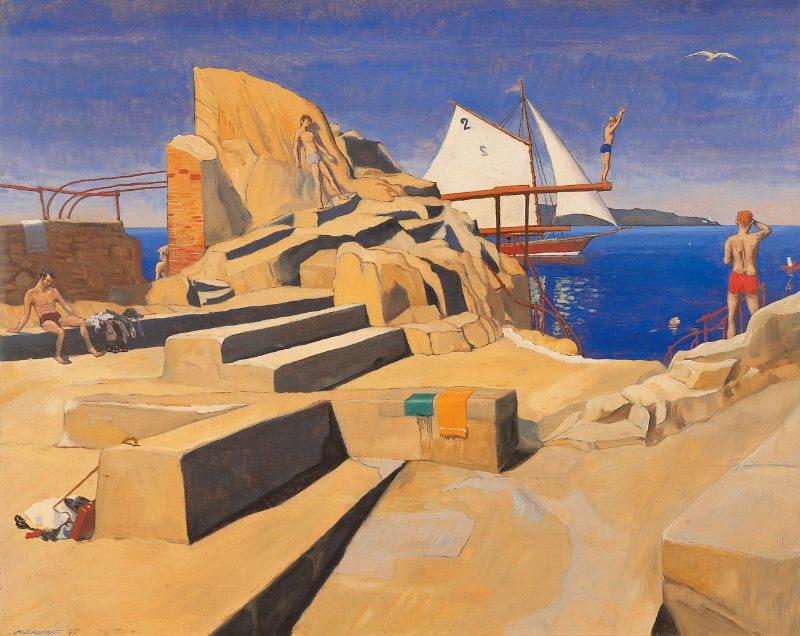
Forty Foot [painting] (Kernoff, 1940) / Art & Literature 32
Building Time / The Forty Foot

33
Sandycove Beach [painting] (Ruth Moloney, n.d.)
An Eternal Monument Frank Kelly

“The granite skirts of the Dublin mountains stretch all the way to where they are lapped by the moody and fickle waters of Dublin Bay, inspiration to some of the great literary intellects of modern times. Some unknowable principle seems to result in the consensus that their ultimate conduit seems to be one minute cove, now in the lee of a fort built in Napoleonic times.”
(Kelly, Power & Pearson, 1987, p.135)
Building Time / The Forty Foot / Art & Literature 34
 The Forty Foot 1860 without the screening wall [photograph] (Power & Pearson, 1987)
The Forty Foot 1860 without the screening wall [photograph] (Power & Pearson, 1987)
A bathing scene at the Forty Foot, Bloomsday 1904
“Buck Mulligan sat down to unlace his boots. An elderly man shot up near the spur of a rock blowing a red face. He scrambled up by the stones, water glistening on his pate abd on its garland of grey hair, water rilling over his chest and paunch and spilling out of his black sagging loincloth.”
(Joyce, 1980)
Drawing of lifebuoy (Wall, 1962 p.30)


Building Time / The Forty Foot / Art & Literature
36

1
Michael Scott’s House (Geragh) 1937-8
Geragh or ‘Michael Scott’s House’ as it is more commonly referred to, is a distinctive 20th century modern house that stands between the Martello Tower and the forty foot. The House was designed by Michael Scott, one of Ireland’s best known 20th century Architects for his own residence. Scott claims to have designed the house in one day stating he ‘started one morning at eight o, clock and by four, o clock the following morning had finished the initial sketch plans’. (Scott & Walker, 1995) The speed at which the house was designed is a reflection of Scott’s affection for the site along with contractual obligations set by the ‘the eccentric old lady’, Mrs Chrisholm Cameron who had sold the site under the condition that construction would start in three years.
Building Time / The Forty Foot / Architecture
38 Geragh House [photograph] (Unknown, c.1930s)
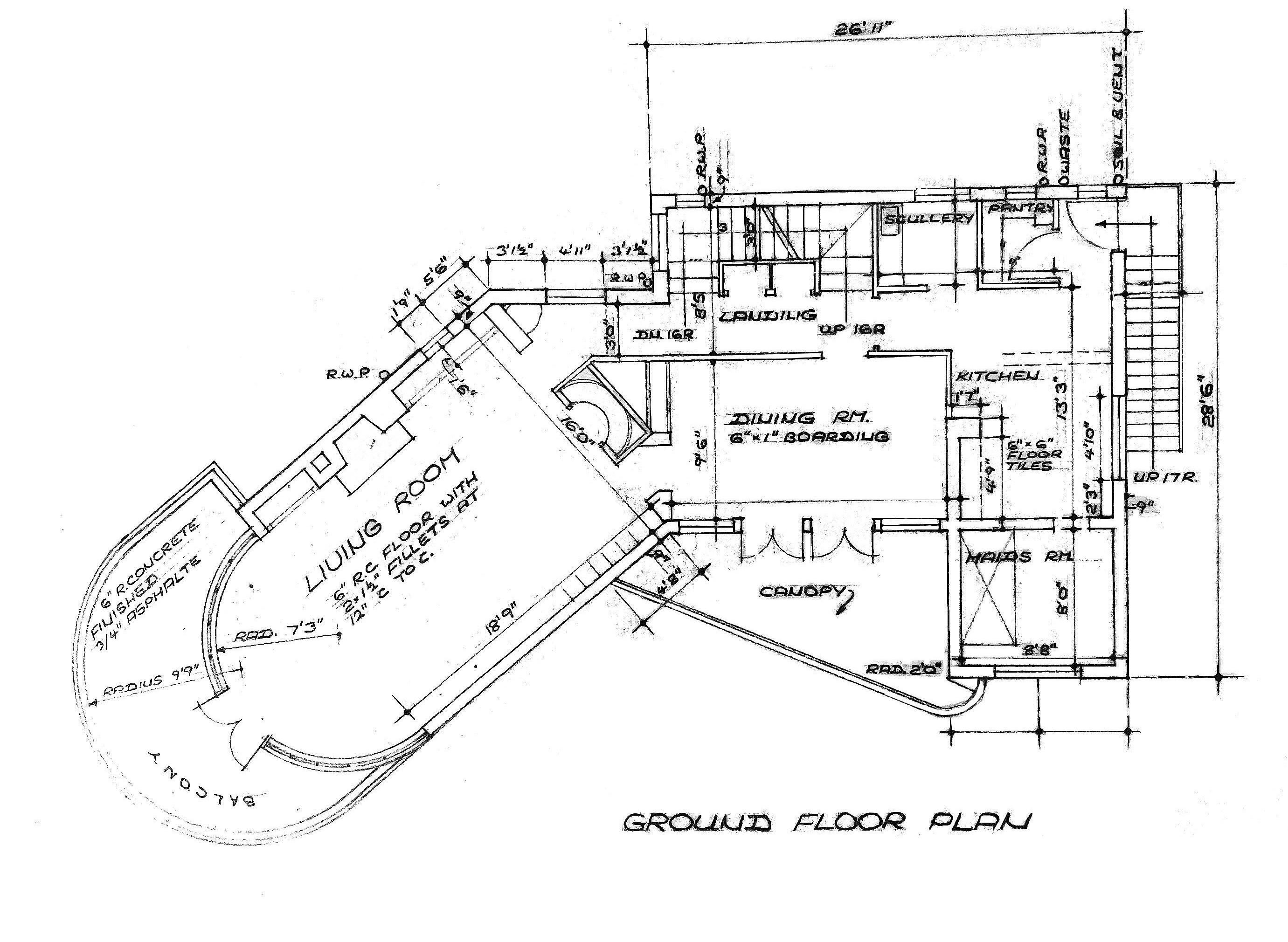
39
Groundl Floor Plan, Geragh House [architectural drawing] (Irish Architectural Archive, 1937)
To the seaward side of the House, a public pathway winds around the site. For the reason of privacy and shelter the house faces towards Dun Laoghaire rather than out to sea. The house was pioneering in its construction methods, being one of the first houses in Ireland constructed with mass concrete. A distinctive feature of the house is its series of curved bays, which echo the curves of the Martello tower and the prevailing style of the 1930s. Maritime imagery is used throughout, including the house’s portholes, railings and series of decks; all of which reflect the sites coastal and defensive context (Archiseek, 2022)
The house has remained largely unchanged since its original construction. The only change that is evident is the that the house no longer sits on stilts. The space underneath has been filled to accommodate the family’s growing needs. Geragh House, admired by many, is a very significant part of the Sandycove coastline and a ‘landmark in the history of architecture’ (Power & Pearson, 1987 p 48)

40
‘Cars and horse drawn carriages outside Micheal Scott;s house, Bloomsday, Sandycove, Co Dublin’ [photogtaph] (National Library of Ireland, 1954)
“Adjoining the Martello tower is a white painted ‘modern’ house which has an unmistakable maritime flavour... A Distinctive 29th century house; it stands betweeb the Martello Tower and the Forty Foot... Scott picked a stunning site, and in his design he echoed the civers of the tower, chosing the international style of the 1930s. Some hate it for its stark simplicity, others admire the way in which steel and concrete were used to creat a ship-like elegance.” (Wall, 1962, p11)
Geragh House South Elevation 1:100
41
Building Time / The Forty Foot / Architecture 42
Martello Tower
The Martello Tower at Sandycove is perhaps the most famous of all 74 stone-built towers built along the shoreline of Ireland due to the influential, James Joyce, partially residing within the tower. James Joyce was invited to stay in the Tower by his friend Oliver St. John Gogarty. He arrived on 9 September 1904 and stayed only six days. The opening chapter of Joyce’s international sensation, ‘Ulysses’ famously describes Sandycove and the sea of the Forty Foot which has given the area international literary reputation.
Today, the tower is a Joycean museum, a place of pilgrimage for Joyce enthusiasts as it holds fascinating mementoes, artefacts, and books connected to the writer. It attracts visits from all over the world, in 2013 over 35,000 people visited the Tower. (Redmond, n.d., para.3)
43
‘Sandycove, Kingstown’ [photograph] (National Library of Ireland, c.1865-1914)

Building Time / The Forty Foot / Architecture
44


45
Martello Tower Site Visit
The Joyce Museum
In 1954 Michael Scott purchased the James Joyce Tower when Mrs Chrisholm Cameron had died. At the time Scott had tried to purchase the tower, but they wouldn’t sell it saying that the tower would have to be purchased with the house beside it. Fearful that Joyce’s Martello Tower would be turned into a restaurant, Scott bid for the house and tower together and ultimately reached an agreement with another bidding party that only wanted the house. The Martello tower was later turned into a museum when scott founded The James Joyce Museum with the financial assistance from film maker John Huston. (Scott & Walker, 1995, p.87)

Building Time / The Forty Foot / Architecture
46
The Martello Tower [architectural drawings] (Pearson, 1998, p.160)
Matello Tower

Plan 47
Matello Tower
Left: Section, Right: Elevation
The Martello Tower [architectural drawings] (Pearson, 1998, p.160)

Building Time / The Forty Foot / Architecture
48

The Battery
The Battery was built shortly after the construction of the Martello Tower. Built from Dalkey granite, the Battery has a military history that extends from the early 1800s until the Emergency during the Second World War. It once held a tall flagstaff or mast with stays rising form the centre and during World War Two a searchlight and anti-aircraft gun were installed. The Battery’s granite walls sit 200 metres of the Forty Foot’s grounds, defensively protecting views and privacy for bathers.
The Battery and Martello Tower housed up to 36 NCO’s and men, but had no piped water supply. (Power & Pearson, 1987, p.49) Therefore, indications imply that the soldiers bathed and swam, in the waters as they garrisoned the area during the Napoleonic invasion.
It passed from State hands into private ownership in 1955, when it was subsequently transformed into a characterful family home. Today it serves as a place-maker of Sandycove harbour and a privacy shield to the bathers of Forty Foot.

Building Time / The Forty Foot / Architecture
50
‘View of Sandycove from Kirkwood Railway Companion in the 1840s [etching] (Power & Pearson, 1987)
Forty
51
Foot Site Plan
Drawing, tracing, recording and thinking through ‘SITUATIONAL INVOLVEMENT’
52
Forty Foot steps [drawing] (Wall, 1962, p.18)

53
‘Material Memory’
The coastal edge at Sandycove has undergone various changes over its history in order to strengthen and take advantage of the community’s direct relationship to the sea. The development of bathing places at Sandycove has altered the course of materiality within the region. The additions of small-scale interventions have greatly boosted the culture of bathing in Sandycove, consequentially giving a sense of place and identity to the area. The range of scales of added infrastructure, along with evidence of various integration of local material to create these nooks and crannies for general well-being, self-expression and interaction with the coast, have established a material memory to the area.

Building Time / The Forty Foot / Drawing, Recording, Thinking 54
Sandycove Harbour and The Forty Foot themselves, are national sensations, places of cultural and historical significance. Bathing culture and the relationship to sea become apparent not only through the repetitive bathers, but also through the wear and tear of the materials present. Of course, the fierce northerly winds force the sea to weather the granite, concrete, and iron – but it is the bathers, the users of the Forty Foot who sit, swim, change and interact with one another and the sea, who shape and mould the materials present; engraving their movement, patterns and habits into the landscape.
The bathing places within Sandycove give evidence to the community’s rhythms and movements from built form through landscape to sea and it is the material that lies between which reveals how important and significant bathing culture is; and it is of utmost importance to analyse, record and publish these coastal spaces of significance.
55

Recording, Thinking
Building Time / The Forty Foot / Drawing,
56
‘Granite Steps Unveiled’ 1995 [photograph] (Pearson, 1998)


57
‘Measuring’ Steps at Forty Foot Alcove

Building Time / The Forty Foot / Drawing, Recording, Thinking 58

59
‘Measuring’ Steps at Forty Foot Alcove

Building Time / The Forty Foot / Drawing, Recording, Thinking 60
‘Measuring’ Steps at Forty Foot Alcove



61

Time / The Forty Foot / Drawing, Recording, Thinking 62
Building


‘Reflecting’ Above: Photographic Collage Right: Steps Survey 63
View of Dún Laoghaire from Forty Foot [drawing] (Wall,1962, p..20)

Building Time / The Forty Foot / Drawing, Recording, Thinking 64
Forty Foot Shelter [drawing] (Wall, 1962, p.15)

65

Recording, Thinking 66
‘Measuring’ Changing Shelter Building Time / The Forty Foot / Drawing,
Elevation
Section
Plan Changing Facility 1:75 67
Changing Facility Axonometric Building
Forty
/
Recording, Thinking 68
Time / The
Foot
Drawing,
Battery Wall [drawing] (Wall, 1962, p.12)

69

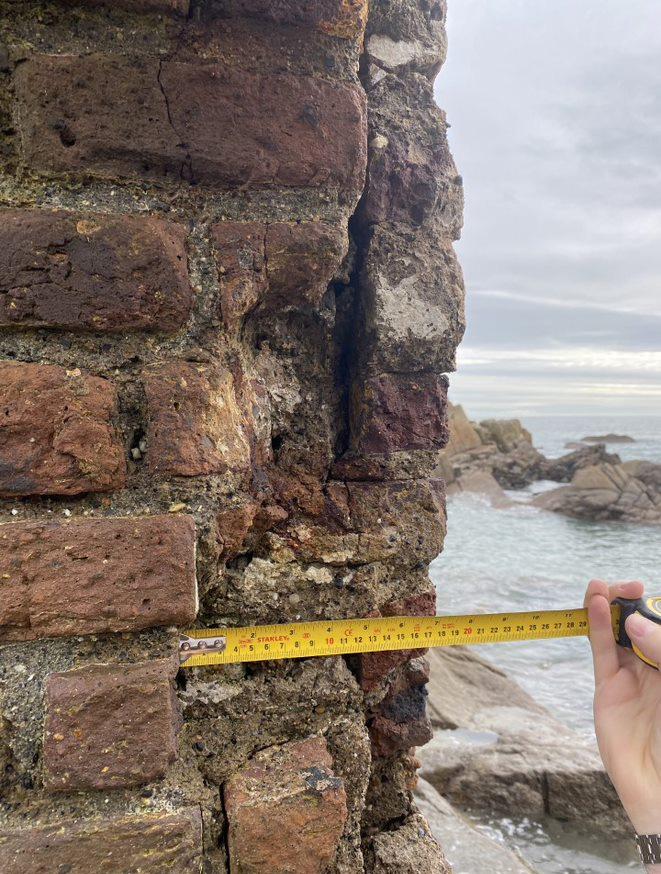
Building Time / The Forty Foot / Drawing, Recording, Thinking ‘Measuring’ Documenting Materiality 70

71

72
‘Measuring’ Outdoor Changing Building Time / The Forty Foot / Drawing, Recording, Thinking
73
Site Plan 1:300 74
Section A-A 1:200 75
Building Time / The Forty Foot / Drawing, Recording, Thinking 76
Section B-B 1:200 77
Building Time / The Forty Foot / Drawing, Recording, Thinking 78


‘Measuring’ The Harbour 79
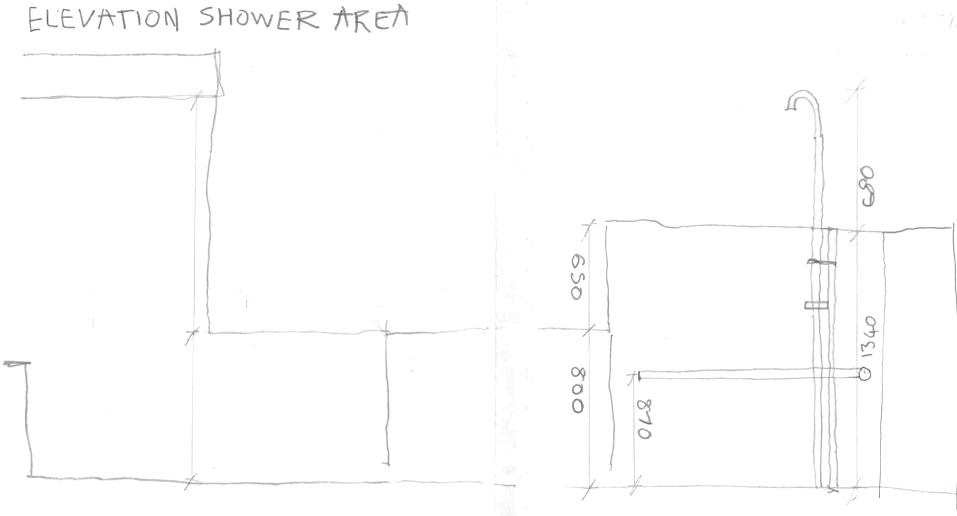



Building Time / The Forty Foot / Drawing, Recording, Thinking 80

‘Measuring’ The Harbour 81

Building Time
The
/
Recording, Thinking
/
Forty Foot
Drawing,
82
Sandycove Harbour [drawng] (Wall,1962, p..9)
Cut Granite Steps at the Harbour


‘Measuring’
83

Cut Granite Steps at the Harbour


‘Measuring’
85

The Forty
/ Drawing, Recording, Thinking 86
Building Time /
Foot
87
Building Time / The Forty Foot / Drawing, Recording, Thinking Site Plan 1:500 88
Section
1:300 89
C-C
Building Time / The Forty Foot / Drawing, Recording, Thinking 90
Section D-D 1:300 91
Building Time / The Forty Foot / Drawing, Recording, Thinking 92
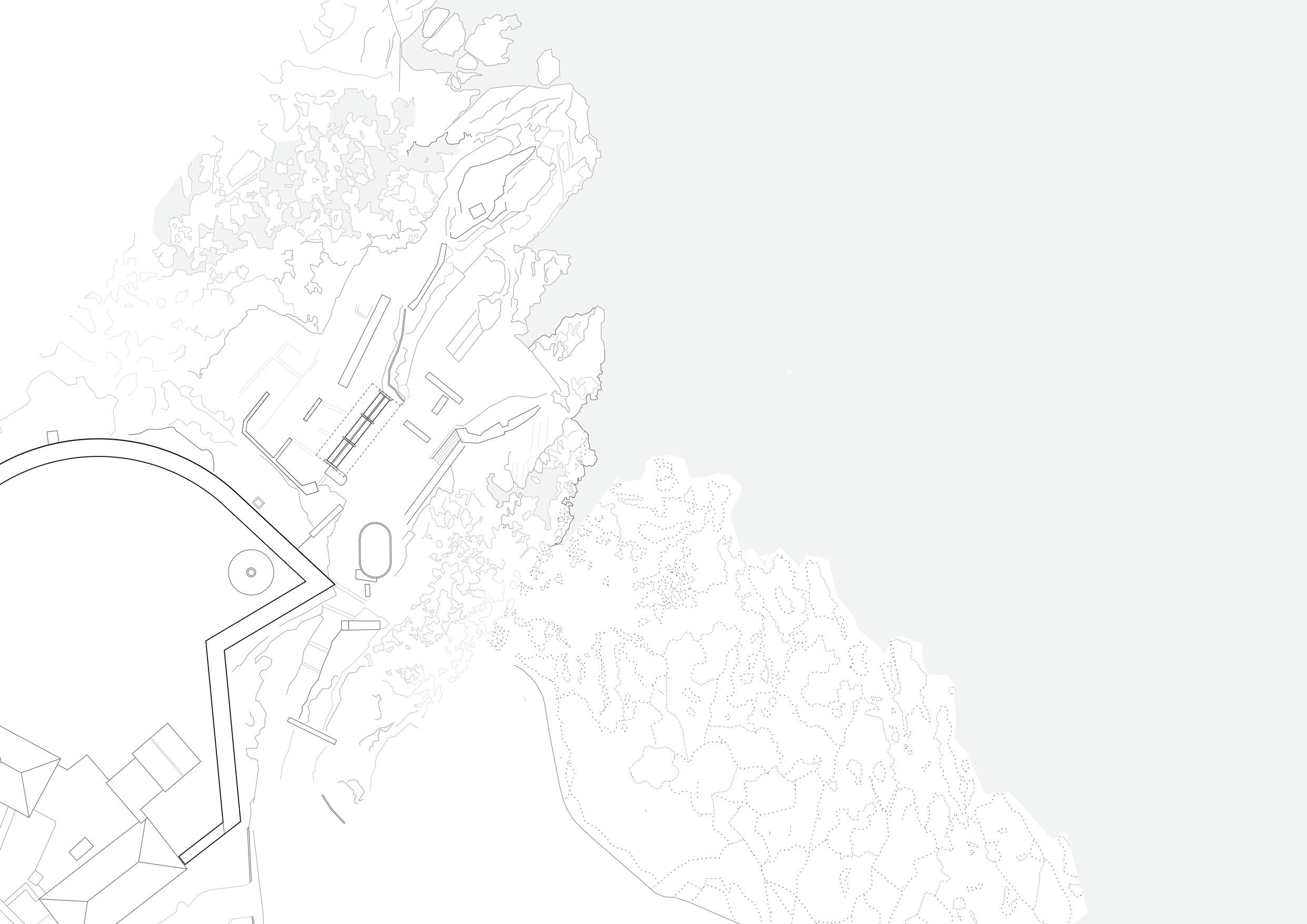
Bibliography
Maps
Archiseek. (2022) 1937 – Geragh, Sandycove, Dun Laoghaire, Co.. Dublin. Available at: https://www.archiseek.com/2010/1937-geraghsandycove-dun-laoghaire-co-dublin
Famous baths (n.d.) Ask about Ireland. Available at: https://www. askaboutireland.ie/learning-zone/primary-students/looking-at-places/dun-laoghaire-rathdown/baths-and-bathing/origins-of-baths-andbath/famous-baths/ (Accessed: December 20, 2022)
Joyce, J. (1980) “1,” in Ulysses. Berlin: Verlag Volk und Welt.
Power, F. and Pearson, P. (1987) The Forty Foot: A Monument to Sea Bathing. Dublin: Environmental Publications Redmond, B. (n.d.) Dún Laoghaire, LocalWiki. Available at: https:// localwiki.org/dl/Joyce%27s_Tower%2C_Sandycove (Accessed: December 22, 2022)
Scott, M. and Walker, D. (1995) Michael Scott, architect: In (casual) conversation with Dorothy Walker. Kinsale Ireland: Gandon Editions. Wall, M. (1962) The Forty Foot: Gentlemen Only. Dublin: Allen Figgis
P. 9) Rocque, J., (1756). Dublin 1756, Reproduced in Bruton, M., Convery, et al., (1987), Sheet no. unkown. No scale. Managing Dublin Bay, University College Dublin. P. 10) War Office, Ltc. Leach, R.P. (1862) Matello Tower no.11 and Sandcove Battery, County of Dublin, 2nd Edition Corrected Jan. 1883, 50 feet to 1 inch. National Archive P. 11) Boundary Commission (1834) Dublin and Kingstown Railway [map] sheet 15. part 2. Scale unk Dublin Historic Maps. P. 12) The Admiralty, (1874). Dublin Bay, 7th edition, Sheet 1415, 1:24500, London. National Library of Ireland.
P.13) Ordenance Survey (1888) County Dublin: Town of Kingstown and Township of Dalkey [map], Sheet XXIII.57, Scale: 1:1056. UCD Digital Library P.14) Civic Survey(1936) Dun Laoghaire Borough Development Map [map] sheet no. unkown. 1:5250. Dublin Historic Maps P.15/16) Civic Survey(1936) Dun Laoghaire Borough Geology Map [map] sheet no. unkown. 1:5250. Dublin Historic Maps
(Inside page) Tisdall, C., (1974). Contemplating Joyce’s “scrotum-tightening Sea, Sandycove” Joseph Beuys at Sandycove. Blogspot. Available at: http://beuysurinal.blogspot.com/2011/08/beuys-at-sandycove.html
P. 8) People Standing on Rocks at Martello. (1911). Retrieved from The National Library. p. 17, 18, 21, 35, 40, 47, 48) Pearson, P. (1998) Between the Mountains and the Sea: Dun Laoghaire Rathdown County. O’Brien Press
P. 20) O’ Shae, D. (1971). Swimmers Dive into the Forty Foot on Christmas Day’ 1971. Reproduced in, Power, F., and Pearson, p. The Forty Foot: A Monument to Sea Bathing. Environmental Publications.
P.25) Short. J (2021) Woman Bathers. John Short Irish Visual Artist P. 26, 30, 36, 53, 64, 65, 69, 82 ) Wall, M. (1962) The Forty Foot: Gentlemen only, Dublin. Allen Figis P. 27, 28) Short. J (n.d ) Spring Swim. John Short Irish Visual Artist P. 29, 30) West. D (n.d) Forty Foot. David West
P. 32) Aaron Kernoff, H. (1940) The Forty Foot Sandycove. Visual Artists Ireland https://visualartists.ie/events/odysseys-group-show-at-crawford-art-gallery/harry-aaron-kernoff-the-forty-foot-sandycove-1940-the-artists-estate_web/ P. 33) Monoley, R. (n.d) Sandycove Beach. Ruth Moloney Art p. 37, 40) Geragh house. c1937. [Photograph]. At: James Joyce Tower and Museum, Dublin p. 39) Scott, M. (Architect). (1937) Geragh House: Ground Floor Plans. Irish Architectural Archive p. 44) (1865-1914) Sandycove, Kingstown. c1865-1914. [Photograph] National Library of Ireland p. 49, 56) Power, F. and Pearson, P. (1987) The Forty Foot: A Monument to Sea Bathing. Dublin: Environmental Publications
Image References

 Nicole Burke Andrew Meaghar Brian Stedmond Shóna Quigley Co-ordinator: Donal Hickey
Photograph of Artist Joseph Bueys at Sandycove (Tisdall, 1994)
Nicole Burke Andrew Meaghar Brian Stedmond Shóna Quigley Co-ordinator: Donal Hickey
Photograph of Artist Joseph Bueys at Sandycove (Tisdall, 1994)



























 The Forty Foot 1860 without the screening wall [photograph] (Power & Pearson, 1987)
The Forty Foot 1860 without the screening wall [photograph] (Power & Pearson, 1987)

















































